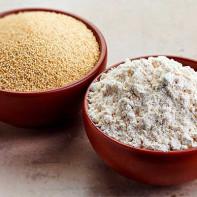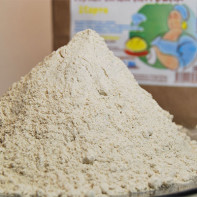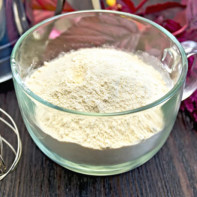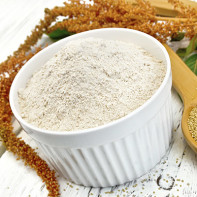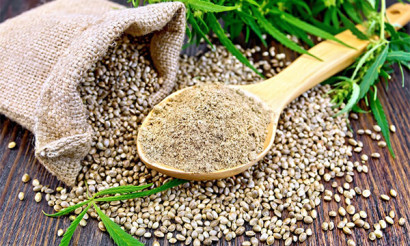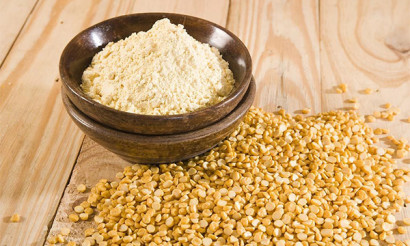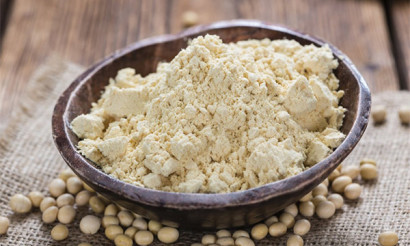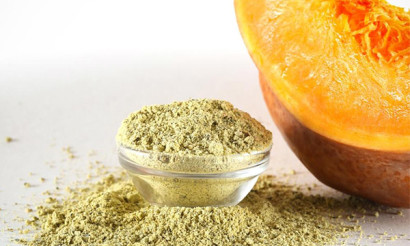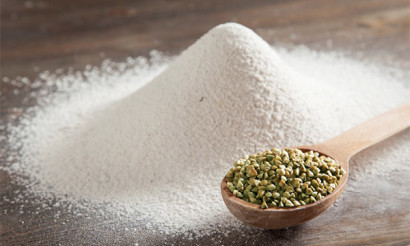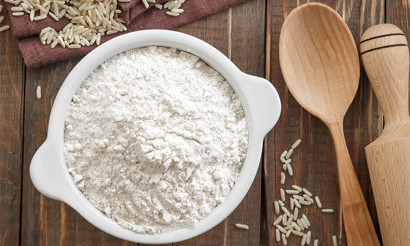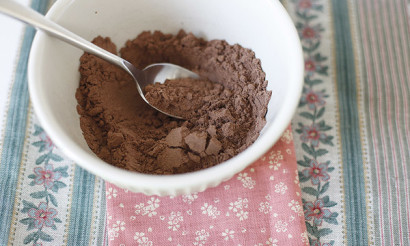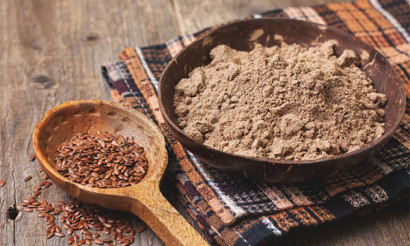Amaranth flour: health benefits and harms
Amaranth flour is a product of processing amaranth seeds. Amaranth, like flour from it, is very valuable in terms of nutrient and vitamin content, so nutritionists recommend eating foods based on it as often as possible.
- Composition and calorie content
- What is useful amaranth flour
- Amaranth flour for weight loss
- Is amaranth flour useful for diabetics?
- Amaranth flour in cosmetology
- How to take amaranth flour
- Harm and contraindications
- What can be prepared from amaranth flour: recipes
- Bread
- Pancakes
- Fritters
- Cookies
- Porridge
- Cupcakes
- Interesting facts about Amaranth
Composition and calorie content
In 100 g of flour - 298 kcal. Amaranth flour does not contain gluten, so it is indispensable for people with intolerance to this protein. Another important advantage of amaranth, and therefore flour, is the presence of a substance such as squalene, which delays the aging process of cells. In addition, it is rich in fiber, iron, magnesium, as well as vitamins A, E, and C. It is also worth noting that flour contains unsaturated fatty acids, which positively affect the circulatory system.

Amaranth flour largely satisfies the need for protein, which is very important, for example, for a vegetarian menu.
Flour contains lysine, an important amino acid that the body cannot produce on its own. There are also phytosterols, fiber, a significant amount of calcium (64 mg), magnesium (120 mg) and iron (4.86 mg).
What is useful amaranth flour
- Gluten free. Flour is great for people with gluten intolerance. The most severe form of intolerance is celiac disease, which causes serious digestive complications. Given that amaranth does not contain gluten, amaranth flour can be consumed by people with intolerance to it.
- Source of protein. Amaranth contains high-quality protein. One cup of cooked amaranth contains about 9 grams of protein, a nutrient that is used by every cell in the human body. It is also very important for building muscle and digestion. Protein will also help improve muscle recovery after a workout.
- Helps fight inflammation. Amaranth flour is an excellent product that helps fight inflammation. And more importantly, it helps treat inflammatory diseases like osteoarthritis and gout. The anti-inflammatory properties of amaranth can be explained by the presence of phytochemicals, which are quite a lot in this food product.
- Bone Health Benefits. Manganese is one of the important minerals found in flour, which plays a significant role in maintaining healthy bones. One cup of amaranth flour provides a daily supply of manganese, which makes this product one of the richest sources of this mineral. Amaranth also contains protein, calcium and iron - nutrients necessary for bone health. Also, regular use of this product helps to restore broken, damaged bones and strengthens them. Consuming amaranth is an effective way to meet the daily needs of calcium and other bone minerals such as zinc and iron.
- Supports the heart. The use of amaranth flour is an excellent prevention of coronary heart disease. The introduction of products based on this flour into the diet can have a beneficial effect on patients suffering from hypertension. It also contains phytosterols, which can lower cholesterol.
- Cancer Prevention The protein contained in flour plays a vital role in the prevention of cancer. It can repair cells that are destroyed by chemotherapy. Amaranth exhibits strong antiproliferative activity against cancer cells. Flour is able to stop their spread. It also contains tocotrienols, belonging to the group of vitamins E, with anti-cancer properties.Tocotrienols play an important role in the treatment and prevention of cancer. Amaranth flour contains a peptide that can inhibit the growth of certain tumors. The same peptide is similar to lunasin, which has antitumor activity.
- Great source of lysine. Flour contains a large amount of lysine (721 mg), which is one of the essential amino acids for the absorption of calcium. It burns fat and supports the skin, tendons, cartilage and bones. Lysine is often used in the treatment of herpes. It is also an immune enhancer.
- Strengthens the immune system. Amaranth, like flour based on it, helps strengthen immunity. This product is especially useful for children with allergies. Amaranth is rich in zinc, a mineral that helps the immune system. Zinc plays an important role, especially in the immune system of older people who are more susceptible to infections. Consuming zinc-containing foods increases the number of T cells that are the type of white blood cells needed for the normal functioning of the immune system. T cells are designed to destroy pathogens that invade the human body.
- Normalizes digestion processes. Amaranth is rich in dietary fiber. Fiber removes cholesterol from the body, which, in addition to helping the heart, helps digestion. About 78 percent of fiber in amaranth is insoluble. Such fiber promotes proper digestion. Flour can be part of a person’s diet with leaking bowel syndrome, an inflammation that prevents large particles of food from entering.
- Improves eyesight. Amaranth flour contains vitamin A, which is known to improve vision.
- Benefits during pregnancy. Amaranth is rich in iron, a mineral that plays a vital role during pregnancy. It helps to deliver oxygen to the child and supports its development, and folic acid is involved in the creation of new cells. Iron also affects DNA synthesis. Folate deficiency leads to a neural tube defect in the newborn. Folate is considered the most important vitamin during pregnancy.
- Improves hair health. Amaranth contains lysine, an amino acid that the body itself cannot produce. Lysine strengthens hair follicles and helps prevent male pattern baldness. Iron in amaranth flour also contributes to healthy hair. This mineral can prevent premature graying.
- Struggling with anemia. Given that flour is rich in iron, its use can help in the fight against anemia, which is the result of a lack of this mineral.
- Source of omega-3 fatty acids. Amaranth is a good source of omega-3 fatty acids. Consuming foods containing omega-3 fatty acids reduces biomarkers associated with many degenerative abnormalities, such as cardiovascular disease, cancer, and various inflammations.
- Lowers blood pressure. The researchers found in amaranth a protein that can inhibit the action of the angiotensin converting enzyme (ACE), a peptide associated with high blood pressure. This means that amaranth flour has an activity similar to ACE inhibitors, and can be used to control blood pressure in patients with hypertension.
- Stimulates energy and longevity. Amaranth flour is an excellent source of essential minerals for the proper functioning of the body. Flour is rich in calcium, folic acid, vitamins, potassium and manganese. All of these nutrients help maintain health, youth, and slow down the symptoms of aging.
- Strengthening blood vessels. Amaranth has in its chemical composition many flavonoids, such as rutin, which help strengthen the walls of the capillaries and effectively fight with the freezing of blood in the veins, which is observed with varicose veins. In addition, vitamin C plays a vital role in the production of collagen, which helps repair and strengthen the walls of blood vessels.
- Lowers cholesterol. Polyphenols (antioxidants) and oils contained in flour help lower levels of bad cholesterol (LDL) and triglycerides.The powerful antioxidant squalene inhibits the production of the enzyme responsible for the production of LDL, all without lowering the level of HDL, good cholesterol.
Amaranth flour for weight loss

Although this is not a specific diet for weight loss, amaranth flour can be an addition to the diet. Fiber, contained in amaranth, helps suppress appetite, and this prevents overeating. It also contains protein, which helps burn fat and strengthen muscles. It affects the production of a hormone responsible for satiety, suppressing a sense of appetite. The flour contains very little fat, and this is very valuable during the diet. The flour is quite low-calorie - only 298 kcal per 100 g.
Is amaranth flour useful for diabetics?
Although amaranth flour has a high glycemic index, surprisingly, it does not have a harmful effect on diabetics. Research has shown that amaranth helps increase insulin levels and lower blood sugar. Therefore, the consumption of amaranth flour in moderation can be beneficial for diabetics.
Amaranth flour in cosmetology
Amaranth flour contains tannins, so it is perfect for making cosmetic masks. For example, flour is very useful for oily skin, as it helps eliminate redness, inflammation, small acne and acne, and is also able to whiten the skin. You can prepare masks for dry skin, as it contains oils, so you will not need to add other oily components.
How to take amaranth flour
Amaranth flour is quite versatile, so it can be used both as the main ingredient of the dish, and as an additional one. Most often, flour is used in baking, which on its basis is aromatic and lush. Flour is suitable for vegetarian cuisine, as well as nutrition for dieters.
Amaranth flour can be used to make pancakes, bread, rolls, muffins, cookies and much more. It is important to note that eating half-baked flour can cause food poisoning.
Harm and contraindications
Despite the benefits of amaranth flour, it also has contraindications. It is forbidden to include flour in the diet:
- with pancreatitis;
- inflammation of the kidneys and urethra;
- cholecystitis;
- the presence of stones in the bile ducts;
- chronic pathologies during an exacerbation.
What can be prepared from amaranth flour: recipes
Bread
This is a recipe for cinnamon based on amaranth flour.

Ingredients:
- 1/2 teaspoon of active dry or instant yeast;
- 200–250 g of warm water;
- 400 g of amaranth flour;
- half a teaspoon of salt;
- 35 g of sugar;
- 85 g of oil;
- 20 g skimmed milk powder;
- 50 g of granulated sugar;
- 1/2 teaspoon ground cinnamon;
- 2 teaspoons unbleached general purpose flour;
- 1 egg
How to do:
- You need to mix the yeast with flour and water, add milk powder, salt. Consider: the more flour is added, the harder and drier the bread will be. After that, the dough is placed in a container, which before this should be lightly greased with oil. Cover it and let the dough rise at room temperature until it doubles - it can take about 60 minutes.
- While the dough rises, make the filling by mixing sugar, cinnamon and flour together.
- Transfer the dough onto a greased work surface. Spread the dough over the entire surface (approximate size is 15 by 50 cm).
- Lubricate the dough with a mixture of eggs and water and sprinkle evenly with the filling.
- Starting at the short end, roll the dough into a bagel.
- Seal the remaining parts with your fingers.
- Transfer the dough to a lightly greased bread pan.
- Let the bread rise (about 1 hour). While the dough rises, preheat the oven to 175ºC.
- Bake bread for 40–45 minutes.
- Remove the bread from the oven. Let it cool completely before slicing.
Pancakes
Ingredients:
- 1 cup amaranth flour;
- 0.5 teaspoon of baking powder;
- half a glass of milk;
- half a glass of water;
- 1 egg
- 1 tablespoon of oil;
- sea salt.
How to do:
- Place flour, salt and baking powder in a bowl. Add milk, water and mix. Then add the egg and beat. Let the dough stand for about an hour.
- Heat the pan, add a little oil, and then a small amount of dough.
- You need to cook until small bubbles appear, then turn over and fry the other side.
Fritters
Ingredients:
- sour kefir or yogurt - 500 ml;
- wheat flour - 100 g;
- amaranth flour - 50 g;
- 2 eggs;
- 2 tbsp. Sahara;
- 1 tsp soda;
- salt.
How to do
In a container filled with kefir, add soda, sugar and salt. While stirring, gradually add flour. First you need to pour amaranth, and then wheat. If the consistency is too thick or liquid, you should add a little flour or kefir.
Fritters must be fried in a small amount of vegetable oil.
Cookies
Ingredients:
- amaranth flour - 130 g;
- butter - 100 g;
- sugar - 100 g;
- chicken egg - 3 pcs.
How to do:
- Beat eggs and sugar.
- Melt the butter, add it to the eggs and mix.
- Then, without stopping stirring, you need to slowly add flour.
- Before placing the dough in molds, it needs to be given 10 minutes to infuse.
- Bake for 10-15 minutes, the temperature should be 200ºC.
Porridge
Ingredients:
- 1 cup of amaranth flour;
- 2 glasses of water;
- salt;
- sugar.
How to do:
- On low heat, pour the flour gradually into the water, stirring occasionally.
- Cook for about 10 minutes. Salt and add sugar.
- Cooked porridge should be flavored with oil (vegetable).
Cupcakes
Ingredients:
- 150 ml of water;
- 100 g of honey;
- 5 g of vanillin;
- 300 g of amaranth flour;
- 30 g of walnuts;
- 80 g of raisins;
- 5 g of cinnamon;
- salt;
- soda;
- ground cinnamon;
- vegetable oil.
How to do:
- Pour water into a container, add honey and oil. Then mix and wait until the honey has melted.
- Add vanillin.
- Take a separate container and mix ground nuts with flour, add salt, soda and cinnamon. Then you need to pour raisins.
- After this dry mixture you need to add to butter and honey and beat.
- Place the dough in molds, fill them in 2/3.
- Put it all in a preheated oven (up to 220 degrees) for half an hour.
Interesting facts about Amaranth
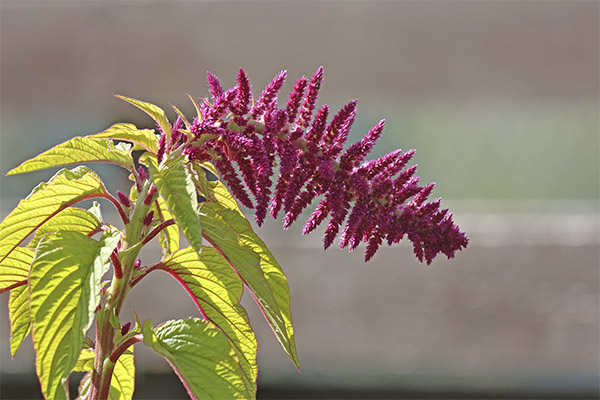
- The name "amaranth" comes from the Greek word "amarantos", which means "eternal" or "unfading". The name refers to the flower buds of amaranth, which retain a bright color even after drying.
- Amaranth was used in various religious ceremonies in the Aztec culture.
- Amaranth leaves are edible and are used in Asian cuisine.
- Amaranth seeds are traditionally consumed with honey and sugar during the Mexican Day of the Dead festival.
- Amaranth seeds are gluten free and can be safely consumed by people diagnosed with celiac disease.
- Amaranth lowers blood cholesterol and lowers the risk of cardiovascular disease, diabetes, and certain types of cancer.
- Amaranth has a straight thick stalk, the height of which can range from a few centimeters to several meters, depending on the species.
- It blooms in summer and autumn. It belongs to the group of self-pollinating plants. Amaranth has wide leaves, which can be light, dark green, reddish, covered with purple streaks or variegated. Has purple, red or gold flowers in the shape of miniature grainy buds. Amaranth completes its life cycle in one or several years, depending on the species.
Amaranth is an excellent source of protein, dietary fiber, vitamin E, iron, calcium, magnesium and omega-3 fatty acids.Amaranth has a better nutritional value than wheat and rice, and in contrast to them, it is an excellent source of L-lysine, an essential amino acid that promotes the absorption of calcium and the synthesis of collagen, elastin, hormones and antibodies in the human body.
«Important: all information on the site is provided exclusively in fact-finding purposes. Before applying any recommendations, consult with a profile specialist. Neither the editors nor the authors are liable for any possible harm caused materials. "

